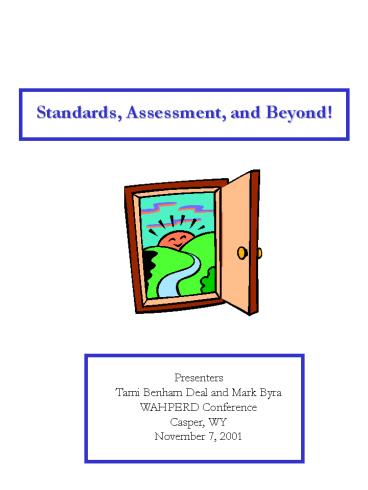Standards, Assessment, and Beyond - PowerPoint PPT Presentation
1 / 18
Title:
Standards, Assessment, and Beyond
Description:
Health and Physical Education Standards written. June, 1999 ... CONTENT STANDARD 2: Fitness. Identifies components, participates in MVPA. Assessment Criteria ... – PowerPoint PPT presentation
Number of Views:71
Avg rating:3.0/5.0
Title: Standards, Assessment, and Beyond
1
Standards, Assessment, and Beyond!
Presenters Tami Benham Deal and Mark Byra WAHPERD
Conference Casper, WY November 7, 2001
2
- Wyoming Legislative Action
- 1995
- Health and Physical Education Standards written
- June, 1999
- Standards adopted by Wyoming State Board of
Education - June, 2000
3
Step 1 Does my school district have standards and
do they align with state standards?
- Issues to consider
- What are my district standards?
- Are revisions needed?
- Matrix state/district standards
- Do we need to develop standards?
- Adopt state standards
- Develop district standards
- Beyond state standards
4
Step 2 Does my health or physical
education curriculum align with district
standards?
- Issues to consider
- Am I teaching to ALL standards?
- Are their gaps?
- How are benchmarks addressed?
5
Step 3 Does my assessment system align with
district standards?
- Issues to consider
- What do I currently assess?
- Do assessments reflect nature of standards?
6
Do Assessments Reflect Nature of Standards?
PE 1 Students demonstrate competency in
movement forms and apply movement concepts and
principles to the learning and development of
motor skills.
Assessment Cumulative points from hitting target
Advanced 50 points Proficient 40
points Partially Proficient 30 points Novice 20
points
Performance Standards Proficient Consistently
demonstrate most skill cues and movement concepts
in the performance of locomotor, object control,
body control skills.
Benchmarks
- Demonstrate/identify
- locomotor skills
- manual control skills
- body control skills
- movement concepts
7
Aligning Standards and Assessments
Scope of Standards
Scope of Assessments
8
Sampling Standards
2. Accessing Information
- Health Promotion Disease Prevention
3. Self-Management
a a a b b b c c c d d d e e e f f f g g g h h h i
i i j j j
4.Analyzing Influences
7. Advocating for Health
6. Goal- Setting Decision- Making
5. Interpersonal Communication
9
Sampling Standards
i
i
2. Accessing Information
i
i
i
i
i
i
- Health Promotion Disease Prevention
h
h
c
e e e
3. Self-Management
h
h
h
d
d
d
d
d
g
a
g
d
d
4.Analyzing Influences
7. Advocating for Health
6. Goal- Setting Decision- Making
5. Interpersonal Communication
10
Step 4 District Assessments What are
they anyway?
- Issues to consider
- How do classroom and district assessments
differ? - What are the common assessments?
- Do I assess more than common assessments?
11
Classroom Assessment System
Skill Tests
Written Tests
Game Play Rubrics
Projects
Homework
Checklists
12
(No Transcript)
13
Creating The District Plan
- Look at the BIG PICTURE
- What is a physically educated or health
educated person? - Determine critical checkpoints in the K-12
continuum - Are certain standards/benchmarks critical to
achieve at specific grade levels because of
learners developmental characteristics? - Are there points in the continuum where data are
needed to help guide instruction (e.g., incoming
seventh graders)? - Are there standards/benchmarks that are not
critical to any specific grade level? - Critically evaluate current assessments
14
District Assessment Matrix
15
District PE Assessment Matrix II
16
(No Transcript)
17
(No Transcript)
18
Assessing Progress Toward Meeting Standards
- State
- Assessment
- Culminating
- Mastery
- Body of
- Evidence
- Classroom
- Assessment
- Drives instruction
- Document progress
- School/
- District
- Assessment
- Level to Level
- Common
- Assessment































